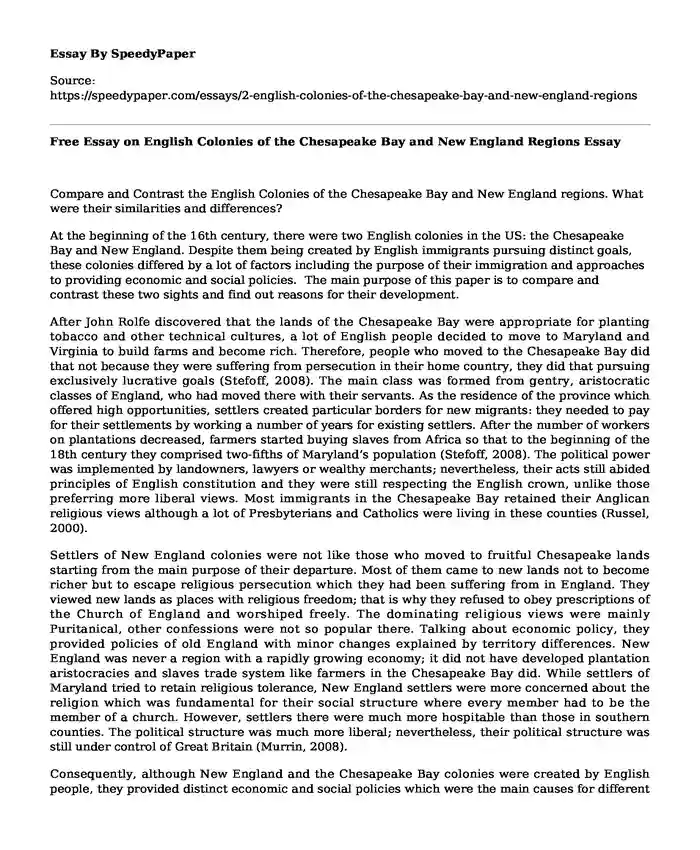
| Type of paper: | Essay |
| Categories: | History United States |
| Pages: | 3 |
| Wordcount: | 663 words |
Compare and Contrast the English Colonies of the Chesapeake Bay and New England regions. What were their similarities and differences?
At the beginning of the 16th century, there were two English colonies in the US: the Chesapeake Bay and New England. Despite them being created by English immigrants pursuing distinct goals, these colonies differed by a lot of factors including the purpose of their immigration and approaches to providing economic and social policies. The main purpose of this paper is to compare and contrast these two sights and find out reasons for their development.
After John Rolfe discovered that the lands of the Chesapeake Bay were appropriate for planting tobacco and other technical cultures, a lot of English people decided to move to Maryland and Virginia to build farms and become rich. Therefore, people who moved to the Chesapeake Bay did that not because they were suffering from persecution in their home country, they did that pursuing exclusively lucrative goals (Stefoff, 2008). The main class was formed from gentry, aristocratic classes of England, who had moved there with their servants. As the residence of the province which offered high opportunities, settlers created particular borders for new migrants: they needed to pay for their settlements by working a number of years for existing settlers. After the number of workers on plantations decreased, farmers started buying slaves from Africa so that to the beginning of the 18th century they comprised two-fifths of Maryland’s population (Stefoff, 2008). The political power was implemented by landowners, lawyers or wealthy merchants; nevertheless, their acts still abided principles of English constitution and they were still respecting the English crown, unlike those preferring more liberal views. Most immigrants in the Chesapeake Bay retained their Anglican religious views although a lot of Presbyterians and Catholics were living in these counties (Russel, 2000).
Settlers of New England colonies were not like those who moved to fruitful Chesapeake lands starting from the main purpose of their departure. Most of them came to new lands not to become richer but to escape religious persecution which they had been suffering from in England. They viewed new lands as places with religious freedom; that is why they refused to obey prescriptions of the Church of England and worshiped freely. The dominating religious views were mainly Puritanical, other confessions were not so popular there. Talking about economic policy, they provided policies of old England with minor changes explained by territory differences. New England was never a region with a rapidly growing economy; it did not have developed plantation aristocracies and slaves trade system like farmers in the Chesapeake Bay did. While settlers of Maryland tried to retain religious tolerance, New England settlers were more concerned about the religion which was fundamental for their social structure where every member had to be the member of a church. However, settlers there were much more hospitable than those in southern counties. The political structure was much more liberal; nevertheless, their political structure was still under control of Great Britain (Murrin, 2008).
Consequently, although New England and the Chesapeake Bay colonies were created by English people, they provided distinct economic and social policies which were the main causes for different levels of their economic development. Whereas the Chesapeake colonies were inhabited by English gentries who desired to become richer, New England colonies were known as places where people could find religious freedom and absence of strict control by the government. Despite these counties using quite different social policies, they both accepted all challenges related to moving to new settlements and successfully built the foundation of the modern USA states which now are located on these lands.
References
Murrin, J. M. (2007). Liberty, equality, power: A history of the American people. Princeton, NJ: Recording for the Blind & Dyslexic.
Russell, D. L. (2000). The American Revolution in the Southern colonies. Jefferson, NC: McFarland & Co.
Stefoff, R. (2008). Cities and towns. Armonk, NY: M.E. Sharpe.
Cite this page
Free Essay on English Colonies of the Chesapeake Bay and New England Regions. (2017, Oct 31). Retrieved from https://speedypaper.com/essays/2-english-colonies-of-the-chesapeake-bay-and-new-england-regions
Request Removal
If you are the original author of this essay and no longer wish to have it published on the SpeedyPaper website, please click below to request its removal:
- Free Essay Example on Hoarding Behavior
- Essay Sample on the Body Weight Issues in the U.S. Today
- Free Essay on Industrialization and Its Global Impacts
- Essay Sample on Charles Manson's Murders and Sociological Theories
- Economics for the Global Manager: Free Essay about Intel Company
- Rear Window, Movie Review Essay Example
- Essay Sample on the Power of Target Market Segmentation in Coca-Cola
Popular categories




